#179: The Genus Crepidotus
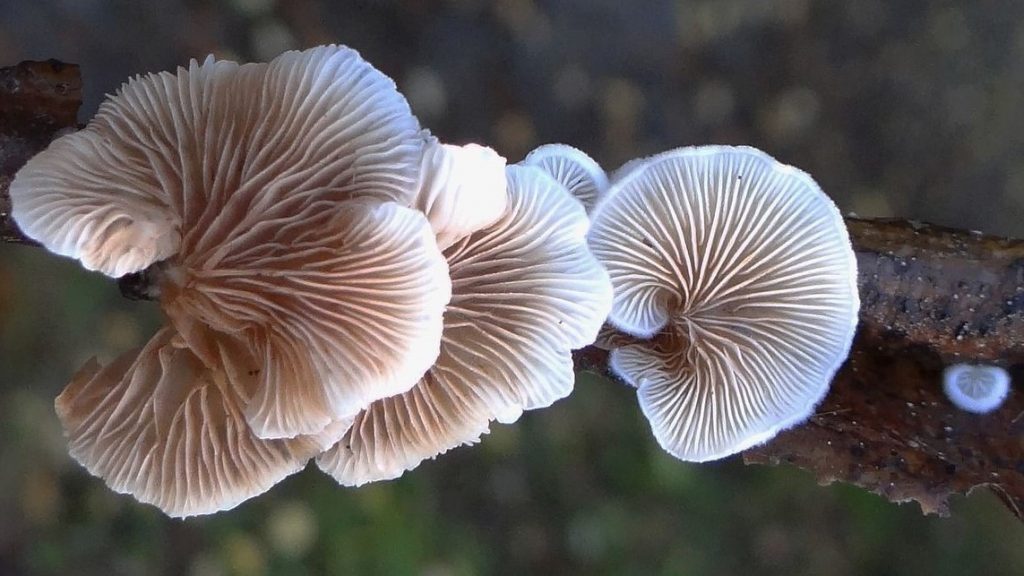
Crepidotus species, such as this C. mollis are known for their brown spore print and lack of a stipe. Photo by: Jerzy Opioła [CC BY-SA 4.0], via Wikimedia Commons (cropped).
Description
Mushrooms in the genus Crepidotus (sometimes ‘crep’ or ‘creps’ for short) are some of the most disappointing mushrooms around. They are not useful for anything, they often fruit in abundance when you can’t find anything else, and they are difficult to identify down to species. If you’re lucky (and happen to be in eastern North America), you may come across a bright red C. cinnabarinus, but that’s about as interesting as these species get. Most of the mushrooms are small and drab.1
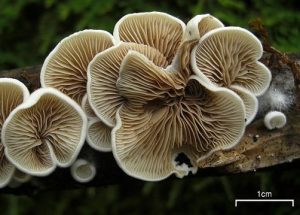
Crepidotus species change shape depending upon where they grow on a log. These mushrooms are underneath a branch and form nearly complete circles. Photo by Jason Hollinger [CC BY 2.0], via Wikimedia Commons(cropped).
Crepidotus species are usually fan-shaped, but this varies depending on the position of the mushroom on its substrate. Normally, the mushrooms fruit from the side of a log. In this case, the pileus orients itself perpendicular to the log and parallel to the ground. This results in the fan shape. If the surface of the log is irregular or curves, the mushroom will have a bit more space to grow and will acquire a kidney-shape. When a Crepidotus fruits underneath or on top of a log, the mushroom has enough space to make a complete (or nearly complete) circle.2
The most interesting cluster of Crepidotus mushrooms I have found was in a bed of mulch. Unfortunately for the mushrooms, this mulch was fairly flat and they couldn’t find a piece tall enough to fruit parallel to the ground. So, they formed perpendicular to the ground instead. This is not an ideal configuration, but demonstrates why stipes are important. When oriented perpendicular to the ground, a spore that drops from one gill will land on the gill directly below it. Most mushrooms solve this problem by lifting the pileus off the ground with a stipe. Crepidotus species don’t need to do this because they fruit from logs, which are already above the ground. Instead of wasting energy on producing a stipe, they simply fruit directly from the side of the log, which is already above the ground. The energy saved allows the mushroom to produce more spores; it also means the mushroom can’t compensate when it finds itself on a reasonably flat surface.
Identification to Species
Crepidotus is not very well treated in field guides, which is hardly surprising given how boring the genus is. North America has over a hundred species of Crepidotus,3 but only Crepidotus experts can readily identify more than a handful of species. Most people are satisfied with knowing the few “charismatic” species presented in field guides. Identifying any Crepidotus with more accuracy than a field guide can provide requires a microscope, a suitably detailed key, and a lot of patience. The go-to key for Crepidotus is North American species of Crepidotus by Hesler and Smith, but you can also try the other papers listed on this page. When attempting to identify a Crepidotus with a microscope, pay particular attention to the spores, the cystidia on the gill edges, the top layer of the pileus, and the presence or absence of clamp connections.4
Edibility
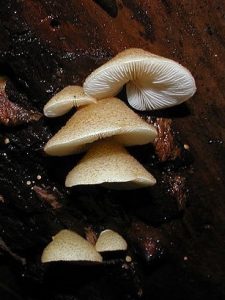
Crepidotus species have thin flesh and are not considered edible. Photo by: Nathan Wilson (nathan) at Mushroom Observer [CC BY-SA 3.0], via Wikimedia Commons (cropped).
Similar Species
Confusion is most likely to occur with other “pleurotoid” mushrooms.2 Pleurotoid means “like Pleurotus” (as in P. ostreatus, the Oyster Mushroom, FFF#021), which also grows on wood, has gills, and has a rudimentary stipe.5 There are many mushrooms that fit this general description, including the Crepidotus species. The best way to separate Crepidotus from other pleurotoid mushrooms is by taking a spore print. Nearly all other pleurotoid mushrooms have pale spore prints.2 The few brown-spored pleurotoid mushrooms from other genera are larger and/or have more brightly-colored flesh than is normal for Crepidotus species (see, for example, Tapinella panuoides).3
To accurately check whether your brown-spored pleurotoid mushroom belongs to Crepidotus, you will need a microscope. Crepidotus species have spores without a germ pore and usually do not have pleurocystidia.1 The previous sentence also describes some species of the closely related genus Simocybe. However, those mushrooms can be differentiated because Simocybe fungi produce smooth spores, have lots of cystidia, and often have a greenish tint to the pileus.6 Mushrooms in Crepidotus can produce either smooth or bumpy spores, but have fewer cystidia and never have a green tinted pileus.2,3,6
Taxonomy
Crepidotus is another one of those groups whose taxonomy was revised recently. Prior to 2004, the genus was placed in the family Crepidotaceae along with a few other microscopically similar genera. However, genetic analysis of that family revealed it was polyphyletic, containing mushrooms from three disparate lineages. After 2004, the only two groups left in the Crepidotaceae were Crepidotus and the stipitate genus Simocybe. These two genera are related to one another and both align closely with the genus Inocybe.6 Apparently, a family consisting of only two genera was too small to justify keeping the name, since both genera now belong in the family Inocybaceae.7,8 The stipitate genera that formerly belonged to the Crepidotaceae now key out alongside stropharioid mushrooms or with little brown mushrooms.6,9
| Kingdom | Fungi |
| Division | Basidiomycota |
| Subdivision | Agaricomycotina |
| Class | Agaricomycetes |
| Subclass | Agaricomycetidae |
| Order | Agaricales |
| Family | Inocybaceae |
| Genus | Crepidotus (Fr.) Staude7 |
This post describes a group of mushrooms and as such the information on this page (including the pictures) cannot be used to identify any mushroom in particular.
This post does not contain enough information to positively identify any mushroom. When collecting for the table, always use a local field guide to identify your mushrooms down to species. If you need a quality, free field guide to North American mushrooms, I recommend Michael Kuo’s MushroomExpert.com. Remember: when in doubt, throw it out!
See Further:
http://www.mushroomexpert.com/crepidotus.html
http://botit.botany.wisc.edu/toms_fungi/jul2007.html
http://www.svims.ca/council/Crepid.htm
http://www.amjbot.org/content/92/1/74.long (scientific paper)
Citations
- Volk, T. J. & Palmer, J. Crepidotus crocophyllus, the orange crep. – Tom Volk’s Fungus of the Month for July 2007. Tom Volk’s Fungi (2007). Available at: http://botit.botany.wisc.edu/toms_fungi/jul2007.html. (Accessed: 3rd March 2017)
- Gibson, I. Notes on CREPIDOTUS in the Pacific Northwest. Pacific Northwest Key Council (2007). Available at: http://www.svims.ca/council/Crepid.htm. (Accessed: 3rd March 2017)
- Miller, O. K. & Miller, H. North American mushrooms: a field guide to edible and inedible fungi. (Falcon Guide, 2006).
- Kuo, M. The Genus Crepidotus. MushroomExpert.Com (2015). Available at: http://www.mushroomexpert.com/crepidotus.html. (Accessed: 3rd March 2017)
- Kuo, M. Oysters: Pleurotoid Mushrooms. MushroomExpert.Com (2005). Available at: http://www.mushroomexpert.com/pleurotoid.html. (Accessed: 3rd March 2017)
- Aime, M. C., Vilgalys, R. & Miller, O. K. The Crepidotaceae (Basidiomycota, Agaricales): phylogeny and taxonomy of the genera and revision of the family based on molecular evidence. Am. J. Bot. 92, 74–82 (2005).
- Crepidotus. Mycobank Available at: http://www.mycobank.org/Biolomics.aspx?Table=Mycobank&Rec=56359&Fields=All. (Accessed: 3rd March 2017)
- Simocybe. Mycobank Available at: http://www.mycobank.org/BioloMICS.aspx?TableKey=14682616000000067&Rec=57385&Fields=All. (Accessed: 3rd March 2017)
- Kuo, M. Key to Dark-Spored, Gilled Mushrooms. MushroomExpert.Com (2014). Available at: http://www.mushroomexpert.com/gilled_dark.html#lbms_wood. (Accessed: 3rd March 2017)


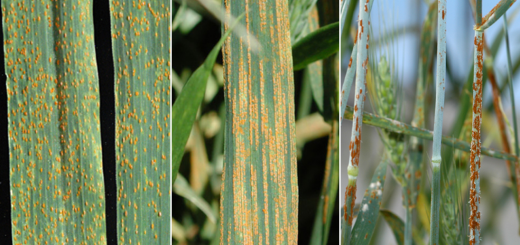
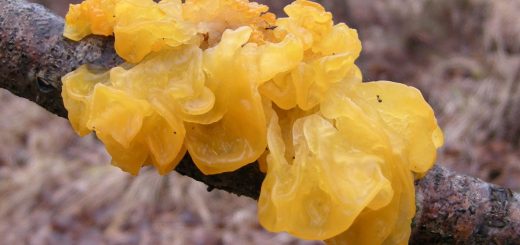





![#011: Characteristics of Kingdom Fungi [Archived]](https://www.fungusfactfriday.com/wp-content/themes/hueman/assets/front/img/thumb-small-empty.png)

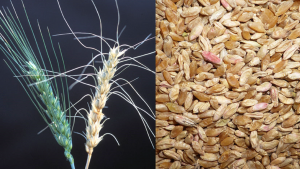
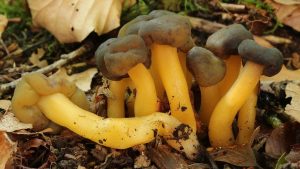
2 Responses
[…] that do distinguish them, there is still some disagreement as to whether or not Crepidotus species (FFF#179) should be considered pleurotoid. Some include the group based on the presence of gills and the […]
[…] Crepidotus25,26 […]